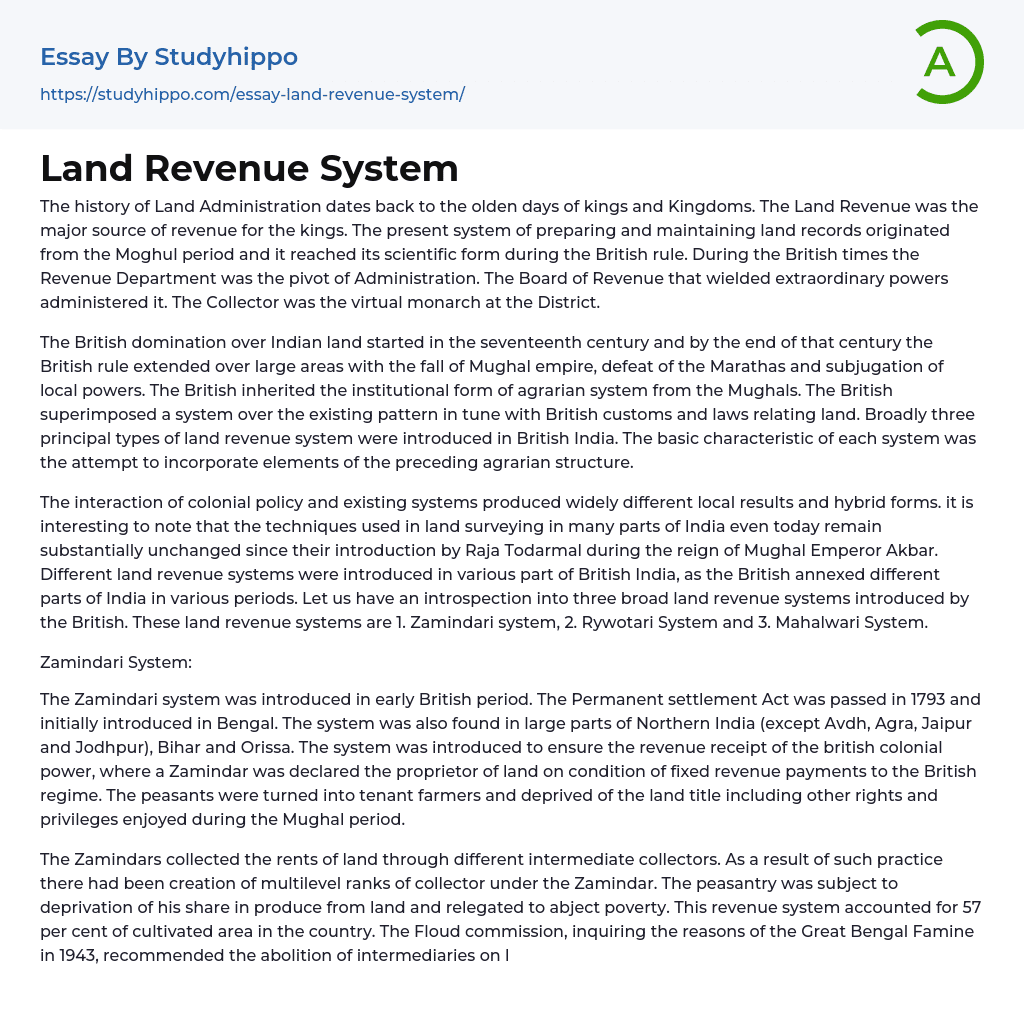Land Administration has its roots in ancient times, with Land Revenue being the primary source of income for kings and kingdoms. The establishment and management of land records evolved during the Moghul period and became more organized under British rule. The administration of this system played a crucial role during the British era.
The British ruled over large areas of India in the seventeenth century, after the fall of the Mughal empire and the defeat of the Marathas and local powers. The Board of Revenue, with its extraordinary powers, administered the land. The Collector, acting as a virtual monarch at the district level, played a significant role in this agrarian system inherited from the Mughals.
The British implemented a land revenue system in British India that conformed to British customs and laws regarding land. This system integrated aspects of the existing agrarian structure
..., resulting in three primary types of land revenue systems. The amalgamation of colonial policy and pre-existing systems produced varied local outcomes and mixed forms. It should be emphasized that the land surveying methods introduced by Raja Todarmal during the rule of Mughal Emperor Akbar are still employed in many regions of India today. As the British progressively annexed different areas of the country over time, diverse regions adopted distinct land revenue systems.
The British implemented three major land revenue systems: the Zamindari system, Rywotari system, and Mahalwari system.
Introduction of the Zamindari System:
The Zamindari system was implemented during the early British period, with the passage of the Permanent Settlement Act in 1793. Initially, it was introduced in Bengal but later extended to various regions in Northern India (excluding Avdh, Agra, Jaipur
and Jodhpur), Bihar, and Orissa. This system aimed to guarantee revenue collection for the British colonial power by giving ownership of land to a Zamindar who had to make fixed revenue payments to the British regime.
The peasants in the Mughal period lost their status and land rights, becoming tenant farmers. The Zamindars collected rent from the land through various intermediaries, resulting in a hierarchy of collectors beneath them. This system led to the impoverishment of the peasantry and their loss of a fair share in agricultural produce. This revenue system covered 57% of the cultivated area in the country.
The Floud commission, inquiring the reasons of the Great Bengal Famine in 1943, recommended the abolition of intermediaries on land interest to the British Government.
Rywotari System:
The Rywotari system was introduced in Madras Presidency in 1792 and in Bombay Presidency in 1817-18. This system recognized the proprietary right of the peasant on land and resembled the revenue system of the Mughal to a great extent. The system covered nearly all the southern states and many western states of India including the erstwhile Central Province (i.e. Madhya Pradesh). Even the princely states of Jaipur and Jodhpur had this category of revenue system, as it existed during the Mughal period.
However, within the Rywotari regions, particularly in the princely states and areas governed by feudal lords, pockets of Zamindri prevailed. The Rywotari system covered approximately 38% of cultivated area in India.
Mahalwari System:
The Mahalwari system, implemented between 1840 and 1850, involved the entire village as a collective unit for revenue settlement. Peasants paid their individual share of revenue for the whole village in proportion to their individual holdings.
The system covered the former
Punjab, parts of Orissa and Madhya Pradesh, and the princely states of Avdh and Agra in Uttar Pradesh. However, it only included 5 per cent of the cultivated land in India. Of the three systems, the Rywotari system bore resemblance to the Mughal revenue system as it acknowledged the cultivators' proprietary rights. This system is considered the most suitable and effective tool for social development. Nevertheless, British legislation introduced the institutionalization of land transfer and the exploitation of the land market, which was nearly non-existent during the Mughal era.
The legislation enacted in the 1850s in Rywotari and Mahalwari areas allowed moneylenders to collect debts from the mortgaged land holdings, leading to a significant effect on the transfer of land. This resulted in the division of rural society in these regions into two groups: landlords and wealthy peasants on one side, and tenants and agricultural laborers on the other side. Consequently, the distribution of land became greatly imbalanced in these areas, as stated by The Royal Commission on Agriculture in 1924-25.
An interesting study has examined agricultural growth rates in relation to the types of tenure systems in different states. The study shows that the former Rywotari and Mahalwari areas in Southern and Western India have achieved higher rates of agricultural growth compared to the former Zamindari areas in Northern and Eastern India.
- Business Law essays
- Contract essays
- Consumer Protection essays
- Property essays
- Ownership essays
- Agreement essays
- Common Law essays
- Contract Law essays
- Justice essays
- Security essays
- Tort Law essays
- United States Constitution essays
- Crime essays
- Lawsuit essays
- Treaty essays
- Family Law essays
- Marijuana Legalization essays
- Constitution essays
- War on Drugs essays
- Court essays
- Jury essays
- Police essays
- Protection essays
- Community Policing essays
- Criminal Law essays
- Judge essays
- Lawyer essays
- Employment Law essays
- Copyright Infringement essays
- Injustice essays
- Intellectual Property essays
- Breach Of Contract essays
- Jurisprudence essays
- Social Injustice essays
- Juvenile Justice essays
- Internet Privacy essays
- Cyber Security essays
- Bill Of Rights essays
- Civil Liberties essays
- First Amendment To The United States Constitution essays
- Fourth Amendment To The United States Constitution essays
- Second amendment essays
- Animal Cruelty essays
- Law Enforcement essays
- Juvenile Justice System essays
- Surveillance essays
- Forensic Science essays
- Crime Prevention essays
- Criminal Justice essays
- Criminology essays




